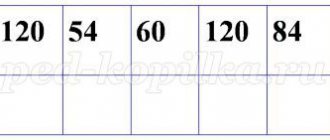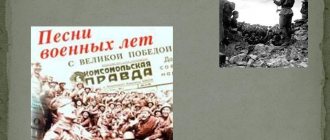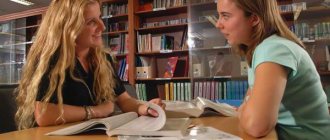Music lesson in 2nd grade on the topic “Tell a story. Lullabies. Mother"
Lesson summary
Subject:
" Tell me a story. Lullabies. Mother"
The purpose of the lesson:
introduce students to the features of a song using the example of lullabies.
Tasks:
Educational:
to develop performing skills in all types of activities, to develop the ability to determine the nature of music and speak out about its sound.
Developmental:
develop an emotional response to music, musical memory, and ear for music.
Educational:
to cultivate a sense of respect for national culture, to cultivate responsibility for the accomplishment of a common cause.
Planned results of the lesson:
Subject:
know the names of works, names of composers, names of musical instruments, consciously and expressively perform music in all types of activities.
Cognitive:
mastering ways to solve problems of a creative and search nature in the process of perception, constructing a speech utterance orally.
Regulatory:
planning, forecasting, control of actions and their results.
Communicative:
planning educational cooperation with the teacher, the ability to express one’s thoughts.
Personal:
the ability to observe various phenomena of life and art, the formation of goodwill and emotional and moral responsiveness.
Means of education
: “March of the Wooden Soldiers” by P.I. Tchaikovsky, “Nanny’s Tale” by P.I. Tchaikovsky, “Tired Toys Sleeping,” “Mother” by P.I. Tchaikovsky, “Fairy Tale” by S.S. Prokofiev.
Lesson progress:
“March of the Wooden Soldiers” by P.I. Tchaikovsky.
Musical greeting.
- I am very glad to meet you. The music you walked into class with helped you remember what we talked about in the last lesson.
Show
emotional responsiveness when perceiving musical works.
- Updating knowledge
- Name the piece of music to which you entered the lesson.
—Who is the composer of this march?
— What did we talk about in the last lesson?
—What kinds of marches are there?
— There are different marches, but what unites all the marches?
- Listen to the music and try to name the topic of our lesson yourself.
We entered to the sound of a march.
The composer of this march is P.I. Tchaikovsky
In the last lesson we talked about a type of march
The march can be: solemn, mourning, fairy-tale, toy.
Clear step and clear rhythm.
I'm watching
t for various manifestations of art in educational activities.
The theme of our lesson is lullabies.
- Problem explanation and recording of new knowledge
-That's right, today we will talk on the topic “Tell a fairy tale. Lullabies. Mother"
— We will continue our acquaintance with the musical works of two outstanding composers P.I. Tchaikovsky and S.S. Prokofiev.
— What works do you know P. Tchaikovsky and S. Prokofiev from?
— Little Petya Tchaikovsky had a nanny. The boy loved to listen to his nanny's tales about Baba Yaga and the Serpent Gorynych, about Vasilisa the Beautiful and Ivan Tsarevich.
— Various wonderful events happen in fairy tales.
— Listen to the play from P.I. Tchaikovsky’s “Children’s Album” “Nanny’s Tale” and think about what this fairy tale will be about? Will there be good or evil fairy tale characters in it?
“Nanny's Tale” by P.I. Tchaikovsky – listening.
- So, what did this fairy tale tell you about?
— Sergei Prokofiev also loved fairy tales. Listen to the “Fairy Tale” that the nanny told little Seryozha.
— What will you imagine when this musical fairy tale plays?
“Fairy Tale” by S.S. Prokofiev – listening.
-So, you have heard the musical fairy tales of P. Tchaikovsky and S. Prokofiev. Think, are these fairy tales the same or different?
— Whose fairy tale did you like the most? Why?
— Guys, what is the melody like in the play “The Fairy Tale” by S. Prokofiev? —
That's right, the play "Fairy Tale" sounds like a lullaby.
—
What is a lullaby?
— Let's look into the musical dictionary and read about lullabies.
- So, what are lullabies? What have you learned about lullabies?
- Listen to the song and think, can it be called a lullaby?
(The teacher plays the song “Hello, my Motherland”)
- Why is this song not a lullaby?
— Listen to the following song and think about whether it can be called a lullaby?
“Tired toys sleep” - listening
-Did you recognize her?
- Show the intonations of the lullaby with your hand movements. What does this movement look like?
— Think about what musical instruments could convey the character of a lullaby? - Guys, think about who performs the first lullaby for a child?
— How many babies fell asleep to the sounds of a simple lullaby. Our grandmothers, great-grandmothers, our mothers sang them. The mother conveys her warmth and tenderness to the baby, affectionately stroking the baby, conveying her feelings of love.
— Listen to P.I. Tchaikovsky’s play “Mama” from “Children’s Album.” What feelings are expressed in it? “Mother” P.I. Tchaikovsky – listening
- You see mother’s gentle hands, kind eyes, friendly smile... Mom hums a lullaby. A lullaby is called the main song in a person’s life. Why? How do you think?
—What lullaby song do you know that you would like to sing yourself?
— How should this song be performed?
“Lullaby of the Bear” - performance (with soloists)
Listen, perceive, analyze.
Based on the works "March of the Wooden Soldiers" and "Procession of the Grasshoppers"
Listen, perceive, analyze.
Recognize
and evaluate the expressiveness of musical speech and its meaning.
Watching
, perceive, identify different types of music.
Carry out
first attempts at composing.
Compare
musical works, based on their experience.
Improvise
taking into account the nature of the music.
Lullaby
- This is one of the oldest genres of folklore. This is usually a song sung to help you calm down and fall asleep.
Express
your emotional attitude to musical images
Staging
fragment from a piece of music.
Pick up
accompaniment to a piece of music.
For the first time, a mother sings a lullaby to a child.
Analyze
and correlate the expressive properties of music.
Thinking
about the genre of music.
"Lullaby of the Bear"
- Primary consolidation in external speech
- Now let’s emphasize the expressiveness of the lullaby’s intonation with a movement of the hand.
-What is needed to expressively perform a lullaby?
Staging
fragment of a piece of music.
They think and analyze.
- Reflection
—
Today I managed...
-It was interesting…
-I learned…
Answer questions.




